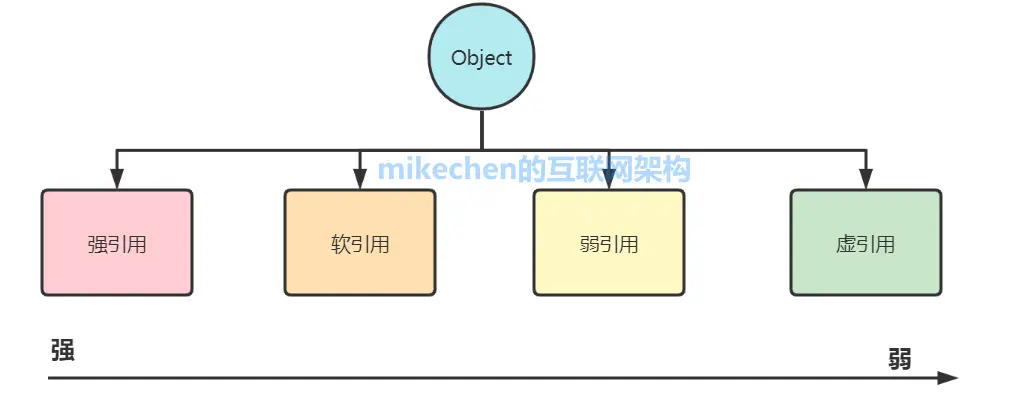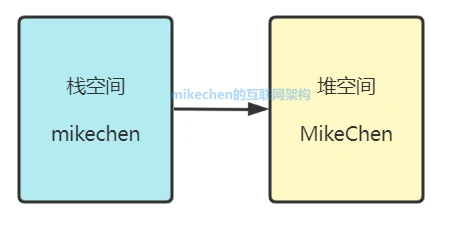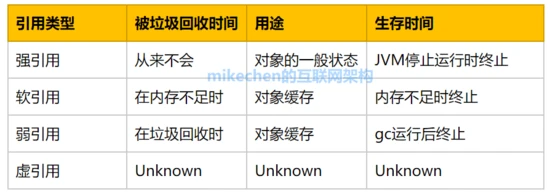Java引用
从JDK 1.2版本开始,对象的引用被划分为4种级别,从而使程序能更加灵活地控制对象的生命周期,这4种级别由高到低依次为:强引用、软引用、弱引用和虚引用。

强引用
强引用是最普遍的引用,一般把一个对象赋给一个引用变量,这个引用变量就是强引用。
比如:
<pre class="hljs fsharp" style="padding: 0.5em; font-family: Menlo, Monaco, Consolas, "Courier New", monospace; color: rgb(68, 68, 68); border-radius: 4px; display: block; margin: 0px 0px 0.75em; font-size: 14px; line-height: 1.5em; word-break: break-all; overflow-wrap: break-word; white-space: pre; background-color: rgb(246, 246, 246); border: none; overflow-x: auto; font-style: normal; font-variant-ligatures: normal; font-variant-caps: normal; font-weight: 400; letter-spacing: normal; orphans: 2; text-align: start; text-indent: 0px; text-transform: none; widows: 2; word-spacing: 0px; -webkit-text-stroke-width: 0px; text-decoration-style: initial; text-decoration-color: initial;">// 强引用
MikeChen mikechen=new MikeChen();
在一个方法的内部有一个强引用,这个引用保存在Java栈中,而真正的引用内容(MikeChen)保存在Java堆中。

如果一个对象具有强引用,垃圾回收器不会回收该对象,当内存空间不足时,JVM 宁愿抛出 OutOfMemoryError异常。
如果强引用对象不使用时,需要弱化从而使GC能够回收,如下:
<pre class="hljs fsharp" style="padding: 0.5em; font-family: Menlo, Monaco, Consolas, "Courier New", monospace; color: rgb(68, 68, 68); border-radius: 4px; display: block; margin: 0px 0px 0.75em; font-size: 14px; line-height: 1.5em; word-break: break-all; overflow-wrap: break-word; white-space: pre; background-color: rgb(246, 246, 246); border: none; overflow-x: auto; font-style: normal; font-variant-ligatures: normal; font-variant-caps: normal; font-weight: 400; letter-spacing: normal; orphans: 2; text-align: start; text-indent: 0px; text-transform: none; widows: 2; word-spacing: 0px; -webkit-text-stroke-width: 0px; text-decoration-style: initial; text-decoration-color: initial;">//帮助垃圾收集器回收此对象
mikechen=null;
显式地设置mikechen对象为null,或让其超出对象的生命周期范围,则GC认为该对象不存在引用,这时就可以回收这个对象,具体什么时候收集这要取决于GC算法。
举例:
<pre class="prettyprint hljs dart" style="padding: 0.5em; font-family: Menlo, Monaco, Consolas, "Courier New", monospace; color: rgb(68, 68, 68); border-radius: 4px; display: block; margin: 0px 0px 1.5em; font-size: 14px; line-height: 1.5em; word-break: break-all; overflow-wrap: break-word; white-space: pre; background-color: rgb(246, 246, 246); border: none; overflow-x: auto; font-style: normal; font-variant-ligatures: normal; font-variant-caps: normal; font-weight: 400; letter-spacing: normal; orphans: 2; text-align: start; text-indent: 0px; text-transform: none; widows: 2; word-spacing: 0px; -webkit-text-stroke-width: 0px; text-decoration-style: initial; text-decoration-color: initial;">package com.mikechen.java.refenence;
/**
* 强引用举例
* * @author mikechen
*/
public class StrongRefenenceDemo {
public static void main(String[] args) {
Object o1 = new Object();
Object o2 = o1;
o1 = null;
System.gc();
System.out.println(o1); //null
System.out.println(o2); //java.lang.Object@2503dbd3
}
}
StrongRefenenceDemo 中尽管 o1已经被回收,但是 o2 强引用 o1,一直存在,所以不会被GC回收。
软引用
软引用是一种相对强引用弱化了一些的引用,需要用java.lang.ref.SoftReference 类来实现。
比如:
<pre class="prettyprint hljs rust" style="padding: 0.5em; font-family: Menlo, Monaco, Consolas, "Courier New", monospace; color: rgb(68, 68, 68); border-radius: 4px; display: block; margin: 0px 0px 1.5em; font-size: 14px; line-height: 1.5em; word-break: break-all; overflow-wrap: break-word; white-space: pre; background-color: rgb(246, 246, 246); border: none; overflow-x: auto; font-style: normal; font-variant-ligatures: normal; font-variant-caps: normal; font-weight: 400; letter-spacing: normal; orphans: 2; text-align: start; text-indent: 0px; text-transform: none; widows: 2; word-spacing: 0px; -webkit-text-stroke-width: 0px; text-decoration-style: initial; text-decoration-color: initial;">String str=new String("abc"); // 强引用
SoftReference<String> softRef=new SoftReference<String>(str); // 软引用
如果一个对象只具有软引用,则内存空间足够,垃圾回收器就不会回收它,如果内存空间不足了,就会回收这些对象的内存。
先通过一个例子来了解一下软引用:
<pre class="prettyprint hljs dart" style="padding: 0.5em; font-family: Menlo, Monaco, Consolas, "Courier New", monospace; color: rgb(68, 68, 68); border-radius: 4px; display: block; margin: 0px 0px 1.5em; font-size: 14px; line-height: 1.5em; word-break: break-all; overflow-wrap: break-word; white-space: pre; background-color: rgb(246, 246, 246); border: none; overflow-x: auto; font-style: normal; font-variant-ligatures: normal; font-variant-caps: normal; font-weight: 400; letter-spacing: normal; orphans: 2; text-align: start; text-indent: 0px; text-transform: none; widows: 2; word-spacing: 0px; -webkit-text-stroke-width: 0px; text-decoration-style: initial; text-decoration-color: initial;">/**
* 弱引用举例
* * @author mikechen
*/
Object obj = new Object();
SoftReference softRef = new SoftReference<Object>(obj);//删除强引用
obj = null;//调用gc
// 对象依然存在
System.gc();System.out.println("gc之后的值:" + softRef.get());
软引用可以和一个引用队列(ReferenceQueue)联合使用,如果软引用所引用对象被垃圾回收,Java虚拟机就会把这个软引用加入到与之关联的引用队列中。
<pre class="prettyprint hljs cs" style="padding: 0.5em; font-family: Menlo, Monaco, Consolas, "Courier New", monospace; color: rgb(68, 68, 68); border-radius: 4px; display: block; margin: 0px 0px 1.5em; font-size: 14px; line-height: 1.5em; word-break: break-all; overflow-wrap: break-word; white-space: pre; background-color: rgb(246, 246, 246); border: none; overflow-x: auto; font-style: normal; font-variant-ligatures: normal; font-variant-caps: normal; font-weight: 400; letter-spacing: normal; orphans: 2; text-align: start; text-indent: 0px; text-transform: none; widows: 2; word-spacing: 0px; -webkit-text-stroke-width: 0px; text-decoration-style: initial; text-decoration-color: initial;">ReferenceQueue<Object> queue = new ReferenceQueue<>();
Object obj = new Object();
SoftReference softRef = new SoftReference<Object>(obj,queue);//删除强引用
obj = null;//调用gc
System.gc();
System.out.println("gc之后的值: " + softRef.get()); // 对象依然存在
//申请较大内存使内存空间使用率达到阈值,强迫gc
byte[] bytes = new byte[100 * 1024 * 1024];//如果obj被回收,则软引用会进入引用队列
Reference<?> reference = queue.remove();if (reference != null){
System.out.println("对象已被回收: "+ reference.get()); // 对象为null
}
软引用通常用在对内存敏感的程序中,比如高速缓存就有用到软引用,内存够用的时候就保留,不够用就回收。
我们看下 Mybatis 缓存类 SoftCache 用到的软引用:
<pre class="prettyprint hljs kotlin" style="padding: 0.5em; font-family: Menlo, Monaco, Consolas, "Courier New", monospace; color: rgb(68, 68, 68); border-radius: 4px; display: block; margin: 0px 0px 1.5em; font-size: 14px; line-height: 1.5em; word-break: break-all; overflow-wrap: break-word; white-space: pre; background-color: rgb(246, 246, 246); border: none; overflow-x: auto; font-style: normal; font-variant-ligatures: normal; font-variant-caps: normal; font-weight: 400; letter-spacing: normal; orphans: 2; text-align: start; text-indent: 0px; text-transform: none; widows: 2; word-spacing: 0px; -webkit-text-stroke-width: 0px; text-decoration-style: initial; text-decoration-color: initial;">public Object getObject(Object key) {
Object result = null;
SoftReference<Object> softReference = (SoftReference)this.delegate.getObject(key);
if (softReference != null) {
result = softReference.get();
if (result == null) {
this.delegate.removeObject(key);
} else {
synchronized(this.hardLinksToAvoidGarbageCollection) {
this.hardLinksToAvoidGarbageCollection.addFirst(result);
if (this.hardLinksToAvoidGarbageCollection.size() > this.numberOfHardLinks) {
this.hardLinksToAvoidGarbageCollection.removeLast();
}
}
}
}
return result;}
注意:软引用对象是在jvm内存不够的时候才会被回收,我们调用System.gc()方法只是起通知作用,JVM什么时候扫描回收对象是JVM自己的状态决定的,就算扫描到软引用对象也不一定会回收它,只有内存不够的时候才会回收。
弱引用
弱引用的使用和软引用类似,只是关键字变成了 WeakReference:
<pre class="prettyprint hljs lisp" style="padding: 0.5em; font-family: Menlo, Monaco, Consolas, "Courier New", monospace; color: rgb(68, 68, 68); border-radius: 4px; display: block; margin: 0px 0px 1.5em; font-size: 14px; line-height: 1.5em; word-break: break-all; overflow-wrap: break-word; white-space: pre; background-color: rgb(246, 246, 246); border: none; overflow-x: auto; font-style: normal; font-variant-ligatures: normal; font-variant-caps: normal; font-weight: 400; letter-spacing: normal; orphans: 2; text-align: start; text-indent: 0px; text-transform: none; widows: 2; word-spacing: 0px; -webkit-text-stroke-width: 0px; text-decoration-style: initial; text-decoration-color: initial;">MikeChen mikechen = new MikeChen();
WeakReference<MikeChen> wr = new WeakReference<MikeChen>(mikechen );
弱引用的特点是不管内存是否足够,只要发生 GC,都会被回收。
举例说明:
<pre class="prettyprint hljs typescript" style="padding: 0.5em; font-family: Menlo, Monaco, Consolas, "Courier New", monospace; color: rgb(68, 68, 68); border-radius: 4px; display: block; margin: 0px 0px 1.5em; font-size: 14px; line-height: 1.5em; word-break: break-all; overflow-wrap: break-word; white-space: pre; background-color: rgb(246, 246, 246); border: none; overflow-x: auto; font-style: normal; font-variant-ligatures: normal; font-variant-caps: normal; font-weight: 400; letter-spacing: normal; orphans: 2; text-align: start; text-indent: 0px; text-transform: none; widows: 2; word-spacing: 0px; -webkit-text-stroke-width: 0px; text-decoration-style: initial; text-decoration-color: initial;">public class WeakHashMapDemo {
public static void main(String[] args) throws InterruptedException {
myHashMap();
myWeakHashMap();
}
public static void myHashMap() {
HashMap<String, String> map = new HashMap<String, String>();
String key = new String("k1");
String value = "v1";
map.put(key, value);
System.out.println(map);
key = null;
System.gc();
System.out.println(map);
}
public static void myWeakHashMap() throws InterruptedException {
WeakHashMap<String, String> map = new WeakHashMap<String, String>();
//String key = "weak";
// 刚开始写成了上边的代码
//思考一下,写成上边那样会怎么样? 那可不是引用了
String key = new String("weak");
String value = "map";
map.put(key, value);
System.out.println(map);
//去掉强引用
key = null;
System.gc();
Thread.sleep(1000);
System.out.println(map);
}}
弱引用的应用
WeakHashMap
<pre class="prettyprint hljs typescript" style="padding: 0.5em; font-family: Menlo, Monaco, Consolas, "Courier New", monospace; color: rgb(68, 68, 68); border-radius: 4px; display: block; margin: 0px 0px 1.5em; font-size: 14px; line-height: 1.5em; word-break: break-all; overflow-wrap: break-word; white-space: pre; background-color: rgb(246, 246, 246); border: none; overflow-x: auto; font-style: normal; font-variant-ligatures: normal; font-variant-caps: normal; font-weight: 400; letter-spacing: normal; orphans: 2; text-align: start; text-indent: 0px; text-transform: none; widows: 2; word-spacing: 0px; -webkit-text-stroke-width: 0px; text-decoration-style: initial; text-decoration-color: initial;">public class WeakHashMapDemo {
public static void main(String[] args) throws InterruptedException {
myHashMap();
myWeakHashMap();
}
public static void myHashMap() {
HashMap<String, String> map = new HashMap<String, String>();
String key = new String("k1");
String value = "v1";
map.put(key, value);
System.out.println(map);
key = null;
System.gc();
System.out.println(map);
}
public static void myWeakHashMap() throws InterruptedException {
WeakHashMap<String, String> map = new WeakHashMap<String, String>();
//String key = "weak";
// 刚开始写成了上边的代码
//思考一下,写成上边那样会怎么样? 那可不是引用了
String key = new String("weak");
String value = "map";
map.put(key, value);
System.out.println(map);
//去掉强引用
key = null;
System.gc();
Thread.sleep(1000);
System.out.println(map);
}}
当key只有弱引用时,GC发现后会自动清理键和值,作为简单的缓存表解决方案。
ThreadLocal
<pre class="prettyprint hljs scala" style="padding: 0.5em; font-family: Menlo, Monaco, Consolas, "Courier New", monospace; color: rgb(68, 68, 68); border-radius: 4px; display: block; margin: 0px 0px 1.5em; font-size: 14px; line-height: 1.5em; word-break: break-all; overflow-wrap: break-word; white-space: pre; background-color: rgb(246, 246, 246); border: none; overflow-x: auto; font-style: normal; font-variant-ligatures: normal; font-variant-caps: normal; font-weight: 400; letter-spacing: normal; orphans: 2; text-align: start; text-indent: 0px; text-transform: none; widows: 2; word-spacing: 0px; -webkit-text-stroke-width: 0px; text-decoration-style: initial; text-decoration-color: initial;">static class ThreadLocalMap {
static class Entry extends WeakReference<ThreadLocal<?>> {
Object value;
Entry(ThreadLocal<?> k, Object v) {
super(k);
value = v;
}
}
//......}
ThreadLocal.ThreadLocalMap.Entry 继承了弱引用,key为当前线程实例,和WeakHashMap基本相同。
虚引用
虚引用”顾名思义,就是形同虚设,与其他几种引用都不同,虚引用并不会决定对象的生命周期。如果一个对象仅持有虚引用,那么它就和没有任何引用一样,在任何时候都可能被垃圾回收器回收。
虚引用也称为“幽灵引用”或者“幻影引用”,它是最弱的一种引用关系。
虚引用需要java.lang.ref.PhantomReference 来实现:
<pre class="prettyprint hljs xml" style="padding: 0.5em; font-family: Menlo, Monaco, Consolas, "Courier New", monospace; color: rgb(68, 68, 68); border-radius: 4px; display: block; margin: 0px 0px 1.5em; font-size: 14px; line-height: 1.5em; word-break: break-all; overflow-wrap: break-word; white-space: pre; background-color: rgb(246, 246, 246); border: none; overflow-x: auto; font-style: normal; font-variant-ligatures: normal; font-variant-caps: normal; font-weight: 400; letter-spacing: normal; orphans: 2; text-align: start; text-indent: 0px; text-transform: none; widows: 2; word-spacing: 0px; -webkit-text-stroke-width: 0px; text-decoration-style: initial; text-decoration-color: initial;">A a = new A();
ReferenceQueue<A> rq = new ReferenceQueue<A>();
PhantomReference<A> prA = new PhantomReference<A>(a, rq);
虚引用主要用来跟踪对象被垃圾回收器回收的活动。
虚引用与软引用和弱引用的一个区别在于:虚引用必须和引用队列 (ReferenceQueue)联合使用,当垃圾回收器准备回收一个对象时,如果发现它还有虚引用,就会在回收对象的内存之前,把这个虚引用加入到与之 关联的引用队列中。
Java引用总结
java4种引用的级别由高到低依次为:强引用 > 软引用 > 弱引用 > 虚引用。





 本文详细讲解了Java中的四种引用类型:强引用、软引用、弱引用和虚引用,包括它们的定义、应用场景和回收机制。了解这些概念有助于更好地控制内存管理和对象生命周期。
本文详细讲解了Java中的四种引用类型:强引用、软引用、弱引用和虚引用,包括它们的定义、应用场景和回收机制。了解这些概念有助于更好地控制内存管理和对象生命周期。
















 364
364

 被折叠的 条评论
为什么被折叠?
被折叠的 条评论
为什么被折叠?








